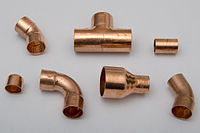
Photo from wikipedia
Abstract Spiral-welded steel tubes (SWTs) are fabricated by helically bending a steel plate and welding the resulting abutting edges. These tubes enable larger diameters, longer joint-less lengths, smaller dimensional tolerances,… Click to show full abstract
Abstract Spiral-welded steel tubes (SWTs) are fabricated by helically bending a steel plate and welding the resulting abutting edges. These tubes enable larger diameters, longer joint-less lengths, smaller dimensional tolerances, and more cost-effective construction compared to other types of steel tubes. Notwithstanding this, the use of SWTs for concrete-filled steel tubes (CFSTs) has been rather limited. Many international design standards contain guidelines on strength assessment of CFST columns. Even so, unlike for other tube types, there is a lack of experimental verification of the applicability of those guidelines for concrete-filled spiral welded steel tube (CF-SWST) columns. This has inhibited their widespread use, especially since the residual stresses in SWTs are generally larger than for other tubes. Given this context, twelve self-compactingCF-SWST short columns with nominal diameters (D)equal to 102, 152, 203 and 229 mm were tested under axial compression, considering load eccentricities of 0, 0.15D and 0.4D. The tube walls were nominally 2 mm thick while the effective length to diameter ratios were in the range 4.5–6.0. A ductile failure mode was observed for all the tests consisting of flexural local buckling in the maximum compression region, which was observed during post-peak deformation. The spiral weld seam was observed to neither provide a preferential location for failure nor be detrimental to the strength capacity. On average, the predicted capacities as per six commonly used international standards agreed well with the experimentally obtained values. The predicted capacities were observed to be more conservative for eccentric loading compared to concentric loading. For eccentric loading, fibre-element analyses using material models proposed for confined concrete provided better predictions of the actual capacity. This suggested that greater confinement benefit than considered in the codes is effective for eccentrically loaded CF-SWST short columns. The study provided evidence of equivalent behaviour of CF-SWST columns to other tested CFSTs and the applicability of existing guidelines for assessing their strength.
Journal Title: Journal of Constructional Steel Research
Year Published: 2018
Link to full text (if available)
Share on Social Media: Sign Up to like & get
recommendations!